Allergies are a common and often misunderstood facet of our health, affecting millions of individuals worldwide. Among the diverse array of allergic reactions, skin manifestations play a significant role in diagnosing and managing allergies. This article aims to delve into the intricacies of allergy spots, providing a comprehensive guide to recognizing their appearance, understanding underlying causes, and exploring effective measures for relief.
Introduction to Allergy Spots
Allergy spots, also known as hives or urticaria, manifest as raised, red, itchy welts on the skin. The appearance of these spots can vary widely, presenting as small dots or large patches. Understanding the distinct features of allergy spots is crucial for timely identification and appropriate management.
Characteristics of Allergy Spots
Color and Texture: Allergy spots typically appear red due to increased blood flow to the affected area. The texture may range from slightly raised to more pronounced welts, depending on the severity of the allergic reaction.
Size and Shape: These spots can vary in size, ranging from small, pinpoint dots to larger, irregularly shaped welts. The size and shape often evolve over time, providing valuable clues about the nature and progression of the allergic response.
Common Causes of Allergy Spots
1. Allergens: Allergy spots often emerge in response to exposure to common allergens, such as pollen, animal dander, dust mites, and certain foods.
2. Medications: Certain medications, including antibiotics, non-steroidal anti-inflammatory drugs (NSAIDs), and certain pain relievers, can induce allergic reactions leading to the development of allergy spots. It is essential for both healthcare providers and patients to be vigilant about potential medication-induced allergies.
3. Insect Bites or Stings: Insect bites or stings from bees, wasps, mosquitoes, or other biting insects can trigger allergic reactions, including the formation of allergy spots. Recognizing the specific insect responsible for the reaction aids in targeted prevention measures.
Diagnosing Allergy Spots
1. Patient History:
The diagnostic journey begins with a comprehensive patient history. Healthcare providers meticulously gather information about recent exposures to potential allergens, the timeline of symptom onset, and any relevant environmental factors. This thorough history aids in identifying patterns and potential triggers.
2. Physical Examination:
A thorough physical examination is paramount in assessing the characteristics of the allergy spots. Healthcare professionals examine the size, shape, and distribution of the welts, ruling out other potential skin conditions and narrowing down the possible causes. Visual cues from the examination help guide further diagnostic steps.
3. Diagnostic Tests:
In certain cases, healthcare providers may recommend specific diagnostic tests to pinpoint the allergen responsible for the allergic reaction. Skin prick tests involve applying small amounts of allergens to the skin and observing the body’s response, while blood tests measure the presence of specific antibodies related to allergic reactions. These tests contribute valuable data to the diagnostic process, aiding in the formulation of targeted treatment plans.
Managing Allergy Spots
1. Allergen Avoidance: The foundation of managing allergy spots lies in identifying and avoiding the triggering allergen. Patients are encouraged to modify their lifestyles, such as adjusting their diets, using hypoallergenic products, and creating allergen-free environments at home.
2. Antihistamines: Over-the-counter or prescription antihistamines are commonly employed to alleviate itching and reduce the appearance of allergy spots. Selecting the appropriate antihistamine and dosage should be guided by a healthcare professional to ensure effective symptom relief.
3. Topical Treatments: For localized allergy spots, topical treatments such as corticosteroids or calamine lotion can be applied to the affected areas. These treatments help reduce inflammation and soothe the skin, providing relief from discomfort.
4. Professional Medical Advice: In cases of severe or persistent allergy spots, seeking professional medical advice is crucial. Allergists and dermatologists can conduct specialized assessments, recommend targeted therapies, and guide individuals towards long-term relief, taking into account the specific characteristics and triggers of the allergy spots.
Chronic Allergic Conditions and Allergy Spots
While allergy spots are often acute and resolve with appropriate management, chronic allergic conditions may require ongoing care. Chronic urticaria, for example, involves persistent or recurrent allergy spots lasting longer than six weeks. Identifying and addressing the root cause is crucial for effective management.
Seeking Professional Advice
In cases of severe or persistent allergy spots, seeking professional medical advice is imperative. Healthcare professionals, including allergists and dermatologists, can conduct specialized assessments, recommend targeted therapies, and guide patients towards long-term relief.
Conclusion
In conclusion, understanding what allergy spots look like is essential for prompt recognition and effective management. By familiarizing ourselves with the characteristics, causes, and diagnostic approaches associated with allergy spots, we empower individuals to take proactive steps in preventing and addressing these common allergic reactions. Through continued research, education, and collaboration with healthcare professionals, we can enhance our collective ability to navigate the complex landscape of allergies and promote overall well-being.
[inline_related_posts title=”You Might Be Interested In” title_align=”left” style=”list” number=”6″ align=”none” ids=”4246,4201,3377″ by=”categories” orderby=”rand” order=”DESC” hide_thumb=”no” thumb_right=”no” views=”no” date=”yes” grid_columns=”2″ post_type=”” tax=””]
































